In case of non-observance of the harvesting time for potatoes, the efforts and time spent on growing will be nullified. Root crops will be poorly stored in the winter, taste will deteriorate, the flesh will become excessively dry or watery. To clean young tubers for food should also be according to certain rules. Calculating the period when you need dig potatoes after flowering take into account many points, independently determine the degree of maturity of the root crop.
Content
What affects potato ripening
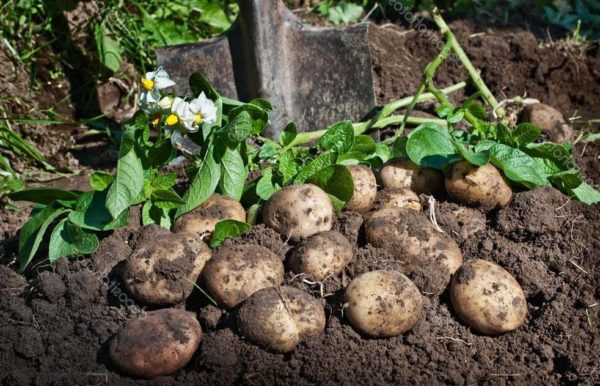
Any sources indicate averaged potato harvesting dates, for example, in the suburbs - this is the period from the last decade of summer until September, when the heat has already ended and the time for rains has not yet arrived. The recommendations are very vague, they should be followed with an eye to a number of circumstances that affect the development of culture, and therefore the establishment of the collection period:
- grade characteristics;
- climate of the region;
- date of disembarkation;
- excessive fertilizer contributes to the formation of powerful greens, root crops develop slowly;
- lack of nutrition provokes a slowdown in bush growth, it blooms late;
- preparation of seed material - germinated faster gives the first sprouts.
Another important point is that if the summer turned out to be hot and dry, while artificial irrigation was not organized, the potatoes will ripen 7-15 days earlier, but will be shallow. In the case of simultaneous planting on adjacent beds of several different varieties with approximately the same vegetation period, the dates when you need to dig potatoes are calculated for each of them separately.
When to pick up young and ripened potatoes
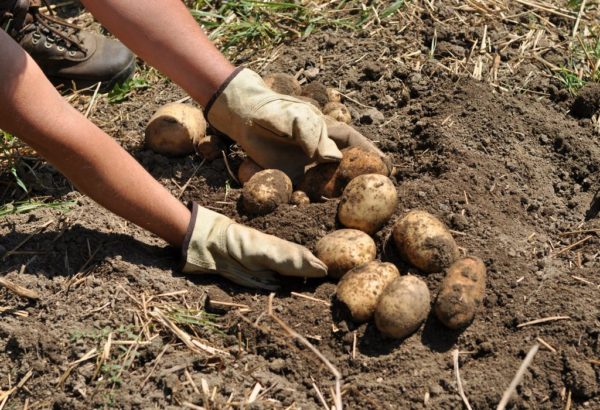
Before the buds begin to form, bushes build up green mass and roots, the tubers are tied in the budding process, and are poured during mass flowering. Young potatoes are harvested for food when the root crops grow to at least 5 cm in diameter, 20–25 days after flowering begins. This moment should coincide with the shedding of withered buds, the cessation of stem growth and the beginning of the formation of berries.
A thin, translucent skin that is easy to remove without cutting the pulp remains for a month (from the beginning of flowering). Only one bush is dug out at once, the taste of tubers depends on the temperature of the earth and the intensity of irrigation, if the potatoes have a fresh taste and watery pulp, the harvest is postponed for 5-15 days. How to determine the moment of complete ripening:
- the potatoes faded, the green mass withered and began to dry;
- the peel of the potato with friction with fingers is not removed;
- the soil around the bushes rose mound, cracked (mature tubers push the soil).
The main sign of the maturation of all potatoes is the condition of the tops, if it began to dry out, digging is carried out after 15-20 days. In some cases, on a common bed, the bushes look different, some are completely dry, while others are still green. In this case, several plants of varying degrees of drying are dug up, tubers are checked, if the skin is dense on all, you can harvest.
Experienced gardeners share other secrets for determining potato maturity.A drop of an iodine alcohol solution is applied to the tuber crop section, the formation of a light purple hue will indicate maturity. Digging a bush with yellowed tops, they hold it with one hand on the stems, and with the other pick the lower fruits, if they are removed without effort, then it's time to dig the potatoes.
How to calculate the ripening period by date
With frequent rains, the stems and leaves can remain juicy and green until mid-autumn. Green mass often dries out ahead of time with an excess of nitrogen. Confusion with the digging of potatoes can occur due to varietal characteristics, some varieties do not produce buds, flowering with the formation of tubers is not always interconnected. In such situations, only calendar calculations are used.
Depending on the region, landing is carried out in April-May. The first seedlings appear after about 2-3 weeks, after another 15-20 days the bushes will bloom, during this period the active formation of root crops begins. On average, young potatoes can be obtained 30–35 days after planting, and fully ripened after 2–2, 5 months. The latest varieties are harvested after about 80 days.
The influence of varietal characteristics on the ripening period
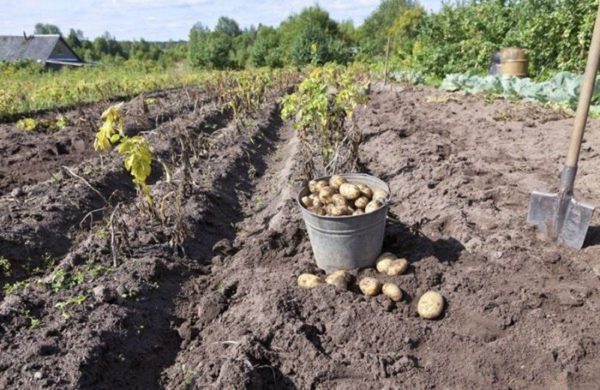
In order to have time to collect potatoes before the onset of cold weather and get a good harvest, varieties are selected based on the climatic characteristics of the region. For example, in the south, gardeners harvest 2 crops of early-ripening tubers or one of the late ones, while the latter do not have time to ripen in summer in areas with a long spring and early autumn frosts. In the table, we highlight the periods of vegetation of individual varieties of culture.
|
Classification |
Days from boarding to picking |
|
Ultra early |
40–60 |
|
Early |
60–70 |
|
Mid early |
70–80 |
|
Average |
80–90 |
|
Medium late |
90–100 |
|
Late (aft) |
100–110 |
The vegetation period is indicated to determine the region, but even taking into account these indicators, an approximate collection period is planned, monitoring the weather, quality of care, and condition of the plants. Ultra-early varieties are usually adapted to cool weather, they are often grown in the northern regions, some suitable both for fresh food and for storage.
Harvest Methods
To minimize the risk of mechanical damage to tubers when digging out, all weeds are removed from the site and the top part of the tops is mowed, leaving stems 10 cm high. The procedure can only be performed in small areas or with partial digging.
They try to harvest the culture before the start of the rainy season in dry, sunny weather at a constant temperature of 13–18 ° C. This is especially true for the period when you need to collect potatoes for storage. Before going to the basement or cellar, the tubers still need to be dried in the fresh air, the procedure takes longer in the room. How to dig potatoes:
- A motoblock or a manual cultivator - a pointed element of the mechanism is immersed in the ground, slowly following the device, not leading it beyond the boundaries of the garden. If this method of harvesting is planned, at least 50 cm are made during planting of the aisles. It is easier to work together with the walk-behind tractor, one person drives the mechanism, and the second removes the potatoes from the ground.
- Bayonet-shovel or pitchfork - the instrument is carefully immersed in the ground at a distance of 20–25 cm from the bush, hold it at an angle of 30 °, lightly press the “shoulder”, raise the nest with tubers above the soil level. Firmly grabbing the bush by the tops, they remove it from the ground. Overdried stems break easily, the plant is dug up from all sides, an earthen lump with root crops is turned out.
Fully ripened potatoes (for storage) are harvested in several ways. In small areas, the bushes are dug up with a shovel or pitchfork, and on large areas they use special equipment or machinery. The second option allows you to speed up and simplify the process, however, the risk of mechanical damage to potatoes increases. Combines are used only in large industrial enterprises, the percentage of "spoilage" is greatly increased.
Why timely collection is important
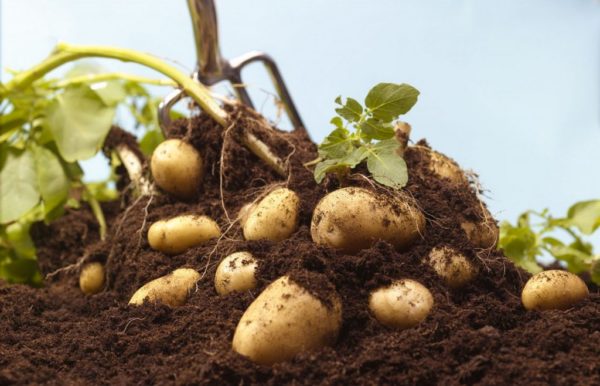
Having made a mistake with the collection period of at least 1-2 weeks, you can lose part, or even the entire crop. If you dig up potatoes too early, it will only be suitable for quick cooking. The peel is thin, subject to various damage, one part of the crop will lose marketability even when harvesting, the other during transportation. Potatoes with scratches, dents or cuts will quickly rot.
Delaying with the collection is also dangerous. It is not easy to dig wet soil and remove tubers from the dirt, drying them out in the open air will not work, and damage to the skin will be invisible. If such specimens are not selected, sent for storage with a total weight, the entire harvested crop can rot in 1-2 months. With late harvesting, the tops manage to overtake, it becomes difficult to find rows and carefully dig up potatoes.
At temperatures above 10 ° C and constant precipitation, the previously fallen tops again overgrow with green leaves, and the tubers begin to sprout. Another minus of the late harvest is autumn frosts, only 1-2 nights with light hoarfrost will reduce the potency of potatoes by 60 or 70%, after being removed from the ground, it will begin to rot, and in the process of preparation will acquire a sweetish aftertaste.
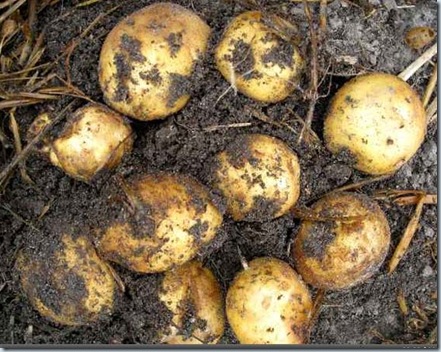 You may be interested in:
You may be interested in:When can start digging potatoes - young after flowering (after 2-3 weeks), and intended for storage, as the tops turn yellow and dry. If you still have doubts, you need to dig a couple of bushes, assess the readiness of the tubers for use. The growing season of the crop can be extended if the potato grows in poor conditions, from the effects of climate, improper care and untimely planting. Potato cultivation should be treated responsibly and not to miss details.




 Description and description of varieties in Belarus with a photo
Description and description of varieties in Belarus with a photo Do I need to pick flowers from potatoes: why do they do it
Do I need to pick flowers from potatoes: why do they do it When to dig potatoes: timing and availability of new potatoes
When to dig potatoes: timing and availability of new potatoes How to grow a good potato crop: various methods and methods, planting and care
How to grow a good potato crop: various methods and methods, planting and care